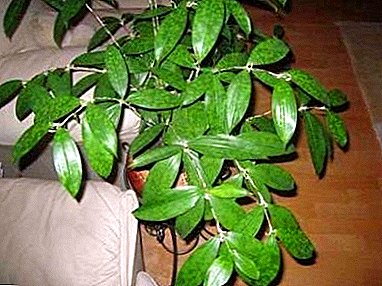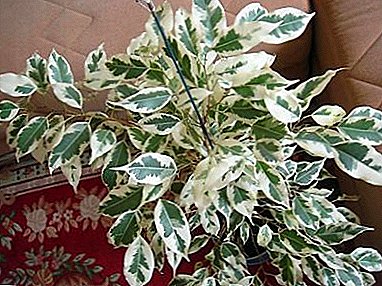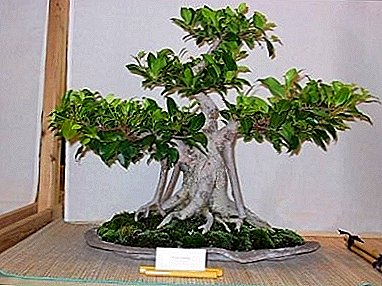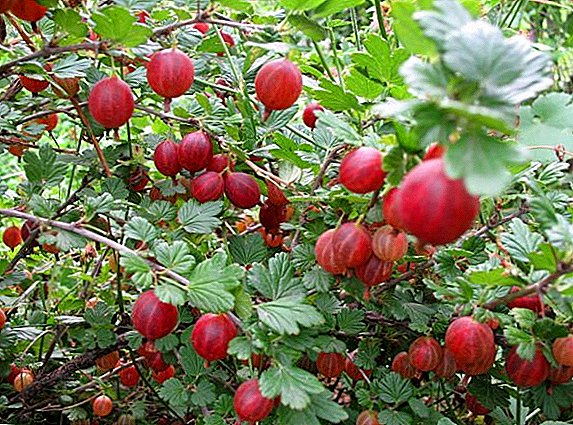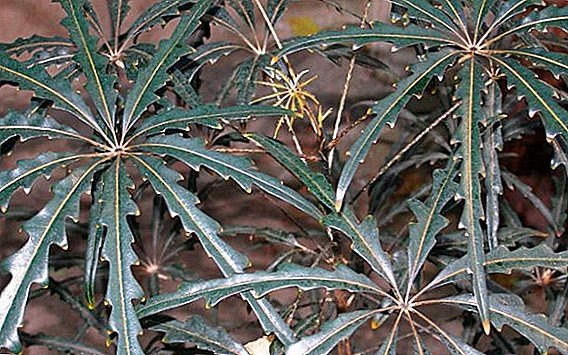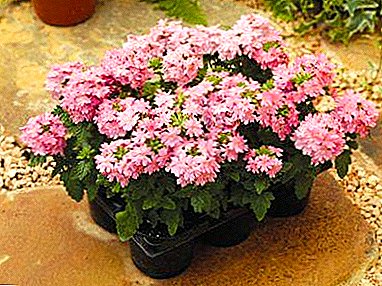
Hybrid Verbena is a garden treasure, an ideal plant for every flower garden because of its ability to bloom from early spring to late autumn.
Unpretentious, durable, thermophilic and colorful vervain awards gardeners with countless floral arrangements throughout the season.
Great for rock gardens and rockeries, creating decorative cascades and "hot summer curbs" of hanging baskets, garden and window containers. In the article we consider the features of planting, as well as how to care for this variety.
Landing features
The easiest way to start growing verbena is to buy seedlings. You can also grow them from seed or dilute cuttings.
- Verbenas require the most sunny places and drained soil. They do not tolerate crowding, shade, poor airing and wetlands. It is best to plant these flowers in spring or summer, but in coastal areas - in the fall.
- Before planting, it is recommended to fertilize the land with humus (about 5 kg / 1 sq. M) and mineral fertilizers. Planting of young plants in open ground is carried out at a distance of 25 cm from each other to a depth not greater than in a box container.
- During planting, the tips of the shoots are pinched to stimulate fluffy growth and abundant flowering.
- Young planted plants should receive regular watering during the first few weeks, before strengthening the root system in the soil. Although vervains are drought-resistant plants, but growth rates, flowering, fertility will decrease if left in dry soil for a long period. In the future, the plant does not require much attention.
Characteristic variety
Under the name Verbena hybrid (Verbenahybrida) combine numerous garden forms and varieties of hybrid origin. This is an annual or perennial plant with a height of 10-50 cm. Leaves: 1-6.5 cm long, opposite, pinnate, often three-lobed, with small lateral lobes.
Flowers: small 1.5-2.5 cm in diameter, collected in 30-50 pieces. in corymbose inflorescences. The corolla is five-lobed two-lipped. Calyx 3-4 mm long, five-toothed, stiff-hairy.
Stems: weakly prostrate, erect, hard-pubescent. Fruits: light brown nuts, assembled in four partseach 2-2.5 mm long, converging at the base of the cup.
A photo
How this plant looks like, you can see in this photo:




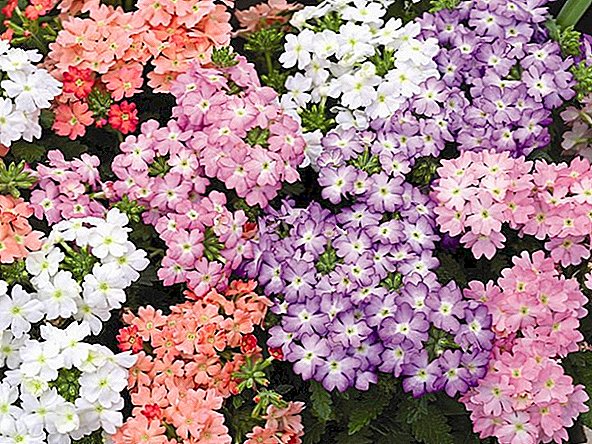
Care
The plant does not require complex care.
- Watering: young plants need regular watering; after ripening and during flowering, it is enough to water the vervains once a week, avoiding excessive soil moisture.
- The soil: medium, well drained, evenly moistened.
- Top dressing: the plant is fed with a complex mineral fertilizer once a year (in spring); You can additionally feed 1-2 times during flowering.
- Trimming: To increase productivity and flowering period, nip or pruning of the shoots is carried out approximately 1/4 of their height; wilted buds are removed.
- Features: It is resistant to high temperatures, requires full solar exposure from 8 to 10 hours daily, fresh air or airing.
Bloom
Vervain blooms from late May to late September. Colorful flowers can be red, white, pink, purple, blue, purple or apricot.
Transfer
For verbena, a light and medium soil substrate is suitable, composed of sheet, peat, humus soil and partly sand.
- Before transplanting, you can disinfect the soil with any fungicide to protect against fungal diseases.
- Plants should be transplanted to a dry or slightly humid soil, since the root system is not injured in this case, and it takes root well during subsequent watering.
- In pots (pots), the drainage hole is covered with a layer of small river pebbles and the dishes are filled with soil mixture.
- After everything is ready for transplantation, the plant is carefully removed from the former substrate, rhizomes are inspected, and the damaged areas are removed. After that, the plant is lowered into the soil poured into the pot, and poured so that the root neck was slightly lower from the edge of the pot while it was not sprinkled with earth.
- Watering just planted plants should be moderate.
- The basic rules for the care of a young plant require bright lighting 8-10 h / day and good air circulation.
The life span of this herb for open ground
One-year and long-term. Although Verbena is considered a perennial plant, gardeners usually grow it for one year, leaving the second year only for grafting.
Breeding
Produced by seeds and cuttings.
Growing from seed
 You can sow the seeds of vervaina right in the garden in autumn or early spring. Indoors, seeds are germinated at the end of winter, but the most suitable time for this is the end of spring or the beginning of summer.
You can sow the seeds of vervaina right in the garden in autumn or early spring. Indoors, seeds are germinated at the end of winter, but the most suitable time for this is the end of spring or the beginning of summer.
- Pre-seeds are soaked in a biostimulator or in ordinary warm water for 24 hours.
- Fibrous cups with the prepared peat mixture are placed on 2 seeds, slightly covering them with the substrate. Boxes for seedlings are also filled with soil substrate and seeded.
- The first watering give moderately warm water around 25ºС.
- Seeds are covered with an opaque film (plastic) with air holes for approximately one month, maintaining the greenhouse temperature and humidity.Attention! Verbena seeds require darkness to germinate, so make sure they are completely covered!
- Inputs appear unevenly, after 2-3 weeks. With the formation of the first leaflets, picking of seedlings grown in boxes is carried out - at intervals of 5 cm x 5 cm. Seedlings in cups do not need to dive.
- Cultivation in a closed form is continued until all shoots produce from three to four leaflets. After that, they are opened and adapted for 10-14 days to open air space and sunlight.
- When young plants are well rooted, they change the water regime for 1 time per week, allowing the soil to dry before the next watering.
- Plants are planted in open ground in early June, observing the spacing of seedlings of 20-30 cm.
Reproduction by cuttings
A stalk is an upper shoot separated from the mother plant, capable of taking root in water or a special substrate. The cuttings are usually carried out from March to April.
- Thickened shoot with a few leaves cut off, the lower part is cleaned.
- Cut stalks deepen in a temporary container with soil of peat and sand.
- The soil is moistened, and the stem stem is shaded until rooting.
- The offspring is stored in a container, gradually tempering and adapting to intense sunlight.
- By transplanting into the open ground young plant is ready when it reaches a quarter of the size of the parent plant.
Diseases and pests
 There are not many pests that affect verbena growth, but aphid, spider mite, thrips and slugs can damage it. Also, the leaves of the plant are often affected by powdery mildew with crowding and excessive watering.
There are not many pests that affect verbena growth, but aphid, spider mite, thrips and slugs can damage it. Also, the leaves of the plant are often affected by powdery mildew with crowding and excessive watering.
When pests and diseases are detected, infected parts of the plant are cut off. Strongly affected specimens should be destroyed. Sick plants are separated from healthy and keep them away the entire period of treatment.
To combat pathogens using natural and chemical agents (soap concentrates, insecticidal preparations).
Verbena is an excellent choice for gardeners looking for a flowering annual with a long flowering and the ability to attract butterflies. It is a versatile, reliable plant in many varieties.. Flower beds are planted and flower pots are hung. On this, the gardener can calm down, since verbena will no longer require any special care, on the contrary, it grows remarkably in natural conditions: bright sunlight, fresh air, good drainage, watering during growth and dry ground during a period of rest. Flowers will delight the eye all summer!


